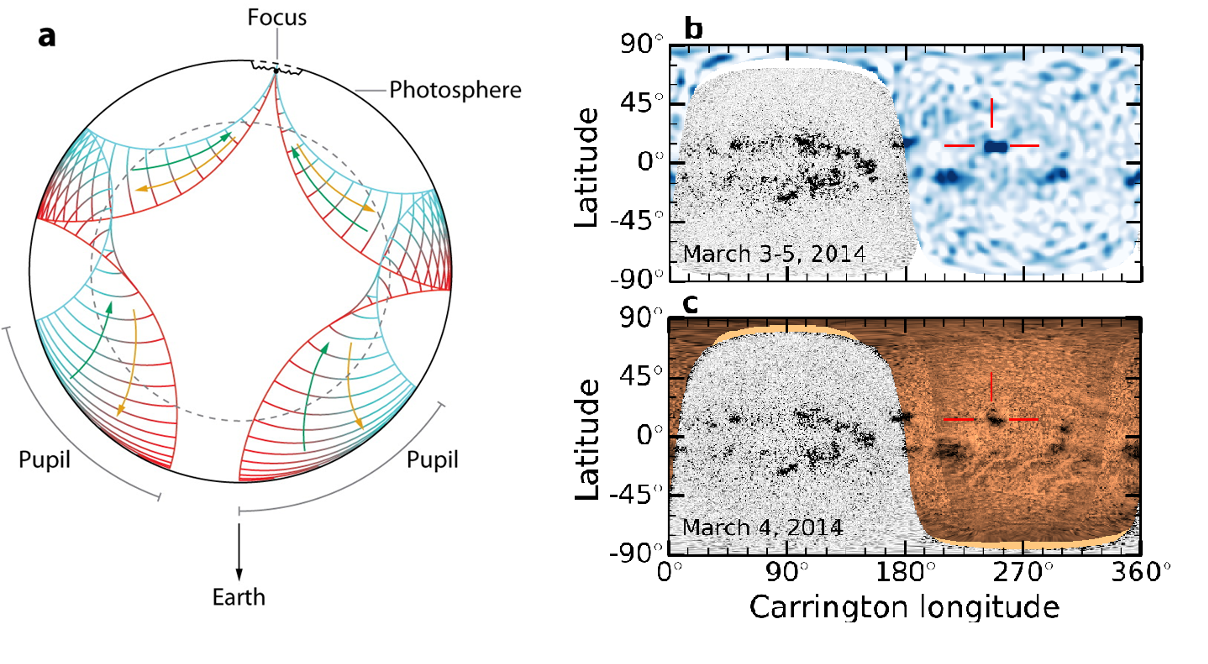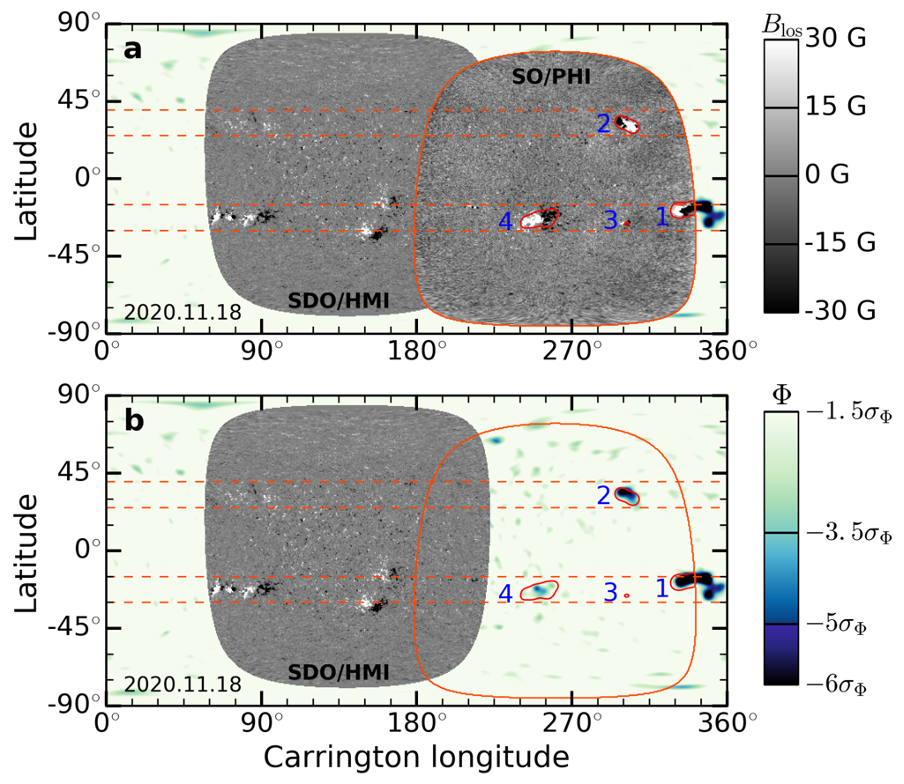Science nugget: Direct assessment of far-side helioseismology using SO/PHI magnetograms - Solar Orbiter
Direct assessment of far-side helioseismology using so/phi magnetograms
(Solar Orbiter nugget #8 Dan Yang1, Laurent Gizon1,2,3, Hélène Barucq4,5 and the SO/PHI team)
Helioseismic imaging is a powerful method to detect active regions on the Sun's far side by using observations of the solar acoustic oscillations. Acoustic waves propagate through the solar interior and connect the far side to the visible side of the Sun (see Fig. 1a for an illustration). Since waves travel faster in magnetised regions, they have the potential to detect active regions along their paths of propagation. Lindsey & Braun (2000) proved this concept to work by cross-correlating the forward and backward propagated waves. This method is known as helioseismic holography and is used routinely to monitor the Sun’s far side. Recent developments in helioseismic holography (Gizon et al.2018; Yang et al. 2023) led to significant improvements in the ability to image active regions on the far side (Fig. 1b), which may also be seen in images of the chromosphere and low corona by NASA’s STEREO spacecrafts (Fig. 1c).

Figure 1: Panel a shows a wave packet travelling from the visible to the far side of the Sun under the ray approximation (Lindsey & Braun, 2000). Panel b shows an example map of the far side on 4 March 2014 (blue) obtained using helioseismology (Yang, Gizon & Barucq, 2023), together with a magnetogram of the front side from SDO/HMI (grey). Panel c shows a contemporaneous STEREO/EUVI image (orange) of the chromosphere and low corona.
The STEREO images of the solar chromosphere are however fuzzy and do not inform us directly about the exact locations of active regions at the Sun’s surface. Photospheric magnetograms are the optimal data to be used for the validation and the calibration of far-side helioseismology. These have only recently become available for the far side during the cruise phase of the Solar Orbiter mission of ESA and NASA. Figure 2 shows the SO/PHI (Solanki et al. 2020) magnetogram on 18 November 2020 (panel a) and the contemporaneous helioseismic image deduced from the SDO/HMI Dopplergrams (panel b). The three largest active regions are clearly seen at the same locations on both the SO/PHI magnetogram and the helioseismic image. This provides the strongest evidence so far that far-side helioseismology works.
Solar Orbiter has entered its nominal mission phase, and the SO/PHI synoptic program will provide magnetograms of the Sun from various vantage points with a cadence of multiple images per day. This means that many more active regions will be used in the future to calibrate the helioseismic far-side maps, and study the emergence and evolution of active regions over the entire solar surface. In particular, it will be possible to convert the signal from far-side helioseismology into active-region magnetic field strength.

Figure 2: Magnetic activity on the entire solar surface on 18 November 2020 during Carrington Rotation CR 2237. The SO/PHI and SDO/HMI magnetograms are shown in panel a. The contemporaneous seismic image is shown in panel b.
This work has been accepted for publication in Astronomy and Astrophysics (forthcoming article) and is available online at https://doi.org/10.1051/0004-6361/202346030.
Affiliations:
(1) Max-Planck-Institut für Sonnensystemforschung, Justus-von-Liebig-Weg 3, 37077 Göttingen, Germany
(2) Institut für Astrophysik, Georg-August-Universität Göttingen, Friedrich-Hund-Platz 1, 37077 Göttingen, Germany
(3) Center for Space Science, NYUAD Institute, New York University Abu Dhabi, PO Box 129188, Abu Dhabi, UAE
(4) Makutu project team, Inria, TotalEnergies, 64000 Pau, France
(5) LMAP, UMR 5142, Université de Pau et des Pays de l'Adour, 64000 Pau, France
References:
[1] L. Gizon, D. Fournier, D. Yang, et al., Astron. Astrophys. 620, A136 (2018)
[2] C. Lindsey & D. C. Braun, Science 287, 1799 (2000)
[3] S.K. Solanki, J.C. del Toro Iniesta, J. Woch, et al, Astron. Astrophys. 642, A11 (2020)
[4] D. Yang, L. Gizon, & H. Barucq, Astron. Astrophys. 669, A89 (2023)
[5] D. Yang, L. Gizon, H. Barucq, et al., Forthcoming Article in Astron. Astrophys. (2023)
Further reading:
L. Gizon, A. C. Birch, & H. C. Spruit, Annu. Rev. Astron. Astrophys. (2010)
- Removed a total of (5) style text-align:left;
- Removed a total of (18) style text-align:justify;
Nuggets archive
2025
09/04/2025: Bursty acceleration and 3D trajectories of electrons in a solar flare
02/04/2025: Picoflare jets in the coronal holes and their link to the solar wind
19/03/2025: Radial dependence of solar energetic particle peak fluxes and fluences
12/03/2025: Analysis of solar eruptions deflecting in the low corona
05/03/2025: Propagation of particles inside a magnetic cloud: Solar Orbiter insights
19/02/2025: Rotation motions and signatures of the Alfvén waves in a fan-spine topology
12/02/2025: 'Sun'day everyday: 2 years of Solar Orbiter science nuggets that shed light on some of our star's mysteries
22/01/2025: Velocity field in the solar granulation from two-vantage points
15/01/2025: First joint X-ray solar microflare observations with NuSTAR and Solar Orbiter/STIX
2024
18/12/2024: Shocks in tandem : Solar Orbiter observes a fully formed forward-reverse shock pair in the inner heliosphere
11/12/2024: High-energy insights from an escaping coronal mass ejection
04/12/2024: Investigation of Venus plasma tail using the Solar Orbiter, Parker Solar Probe and Bepi Colombo flybys
27/11/2024: Testing the Flux Expansion Factor – Solar Wind Speed Relation with Solar Orbiter data
20/11/2024:The role of small scale EUV brightenings in the quiet Sun coronal heating
13/11/2024: Improved Insights from the Suprathermal Ion Spectrograph on Solar Orbiter
30/10/2024: Temporally resolved Type III solar radio bursts in the frequency range 3-13 MHz
23/10/2024: Resolving proton and alpha beams for improved understanding of plasma kinetics: SWA-PAS observations
25/09/2024: All microflares that accelerate electrons to high-energies are rooted in sunspots
25/09/2024: Connecting Solar Orbiter and L1 measurements of mesoscale solar wind structures to their coronal source using the Adapt-WSA model
18/09/2024: Modelling the global structure of a coronal mass ejection observed by Solar Orbiter and Parker Solar Probe
28/08/2024: Coordinated observations with the Swedish 1m Solar Telescope and Solar Orbiter
21/08/2024: Multi-source connectivity drives heliospheric solar wind variability
14/08/2024: Composition Mosaics from March 2022
19/06/2024: Coordinated Coronal and Heliospheric Observations During the 2024 Total Solar Eclipse
22/05/2024: Real time space weather prediction with Solar Orbiter
15/05/2024: Hard X ray and microwave pulsations: a signature of the flare energy release process
01/02/2024: Relativistic electrons accelerated by an interplanetary shock wave
11/01/2024: Modelling Two Consecutive Energetic Storm Particle Events observed by Solar Orbiter
2023
14/12/2023: Understanding STIX hard X-ray source motions using field extrapolations
16/11/2023: EUI data reveal a "steady" mode of coronal heating
09/11/2023: A new solution to the ambiguity problem
02/11/2023: Solar Orbiter and Parker Solar Probe jointly take a step forward in understanding coronal heating
25/10/2023: Observations of mini coronal dimmings caused by small-scale eruptions in the quiet Sun
18/10/2023: Fleeting small-scale surface magnetic fields build the quiet-Sun corona
27/09/2023: Solar Orbiter reveals non-field-aligned solar wind proton beams and its role in wave growth activities
20/09/2023: Polarisation of decayless kink oscillations of solar coronal loops
23/08/2023: A sharp EUI and SPICE look into the EUV variability and fine-scale structure associated with coronal rain
02/08/2023: Solar Flare Hard Xrays from the anchor points of an eruptive filament
28/06/2023: 3He-rich solar energetic particle events observed close to the Sun on Solar Orbiter
14/06/2023: Observational Evidence of S-web Source of Slow Solar Wind
31/05/2023: An interesting interplanetary shock
24/05/2023: High-resolution imaging of coronal mass ejections from SoloHI
17/05/2023: Direct assessment of far-side helioseismology using SO/PHI magnetograms
10/05/2023: Measuring the nascent solar wind outflow velocities via the doppler dimming technique
26/04/2023: Imaging and spectroscopic observations of EUV brightenings using SPICE and EUI on board Solar Orbiter
19/04/2023: Hot X-ray onset observations in solar flares with Solar Orbiter/STIX
12/04/2023: Multi-scale structure and composition of ICME prominence material from the Solar Wind Analyser suite
22/03/2023: Langmuir waves associated with magnetic holes in the solar wind
15/03/2023: Radial dependence of the peak intensity of solar energetic electron events in the inner heliosphere
08/03/2023: New insights about EUV brightenings in the quiet sun corona from the Extreme Ultraviolet Imager








































 Sign in
Sign in
 Science & Technology
Science & Technology